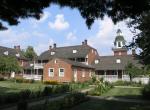![header=[Marker Text] body=[Maintained by the Pennsylvania Historical and Museum Commission as a State memorial to the Harmony Society, organized February 15, 1805, dissolved December 15, 1905. These buildings erected 1824-1831, comprise a portion of the third settlement by the society. 1st Settlement – Harmony, Butler Co., Pa., 1804-15; 2nd Settlement – New Harmony, Posey Co., Ind., 1814-25; 3rd Settlement – Economy, Beaver Co., Pa., 1824-1905.
] sign](kora/files/1/10/1-A-54-139-ExplorePAHistory-a0a2z5-a_450.gif)
Mouse over for marker text
Name:
Old Economy Memorial
Region:
Pittsburgh Region
County:
Beaver
Marker Location:
Old Economy, 13th & Church Streets, Ambridge
Behind the Marker
Following an eleven-year legal battle for control of the Harmony Society's estate, John and Susie Duss reached an agreement with the State of Pennsylvania in 1916. The two parties split what remained of the Harmonists' once vast fortune equally. Since John Duss had previously sold the vast majority of Economy's lands to the Berlin Iron Works in 1894 and to U.S. Steel in 1902, the remaining property, also ceded to the state, consisted of only one square block of the original tract of land. The state invested its share of the money it received in a fund to preserve part of the Harmony Society's history.
Today, the Pennsylvania Historical and Museum Commission maintains Old Economy as a memorial and museum. Situated on six acres in Ambridge, Old Economy Village includes seventeen buildings that Harmony Society's members constructed between 1824 and 1831.
Old Economy Village includes seventeen buildings that Harmony Society's members constructed between 1824 and 1831.
Although the museum represents only a small part of Rapp's once active religious community, the buildings and grounds reflect the culture and values of the people who built them. For the Harmonists religious symbols abounded in nature. At the center of Economy they placed a formal garden, which they planted with lilies and roses to represent the glory of God and the Resurrection.
A garden pavilion houses not a statue of Christ or saint, but a colossal wooden carving that looks like the figurehead of a ship. This allegorical figure represented "Harmony," the ultimate goal of their religious community. In 1826, a visitor from Germany described the garden as "containing several acres of flowers and vegetables, as well as a vineyard, situated on a terrace-shaped half-circle on the hill, ending in a bower." More recently, the great garden at Economy has been maintained by the museum staff and local gardening clubs, which strive to cultivate only plants that could have grown there in 1830.
Thanks to a tradition of tolerance that stretches back to William Penn and the German religious dissenters who flocked to his colony, Father Rapp and his followers were able to establish their religious society in Pennsylvania. Here they created a stable, prosperous, and generally harmonious community that served as a model for communitarians from both sides of the Atlantic Ocean.
Although the Second Coming did not occur as they had hoped, their hard work earned them both spiritual satisfaction and earthly rewards. The museum and archives at Old Economy preserve and document the Harmony Society as a lasting memorial to their faith and to Pennsylvania's unique history of religious toleration.
Today, the Pennsylvania Historical and Museum Commission maintains Old Economy as a memorial and museum. Situated on six acres in Ambridge,
Although the museum represents only a small part of Rapp's once active religious community, the buildings and grounds reflect the culture and values of the people who built them. For the Harmonists religious symbols abounded in nature. At the center of Economy they placed a formal garden, which they planted with lilies and roses to represent the glory of God and the Resurrection.
A garden pavilion houses not a statue of Christ or saint, but a colossal wooden carving that looks like the figurehead of a ship. This allegorical figure represented "Harmony," the ultimate goal of their religious community. In 1826, a visitor from Germany described the garden as "containing several acres of flowers and vegetables, as well as a vineyard, situated on a terrace-shaped half-circle on the hill, ending in a bower." More recently, the great garden at Economy has been maintained by the museum staff and local gardening clubs, which strive to cultivate only plants that could have grown there in 1830.
Thanks to a tradition of tolerance that stretches back to William Penn and the German religious dissenters who flocked to his colony, Father Rapp and his followers were able to establish their religious society in Pennsylvania. Here they created a stable, prosperous, and generally harmonious community that served as a model for communitarians from both sides of the Atlantic Ocean.
Although the Second Coming did not occur as they had hoped, their hard work earned them both spiritual satisfaction and earthly rewards. The museum and archives at Old Economy preserve and document the Harmony Society as a lasting memorial to their faith and to Pennsylvania's unique history of religious toleration.







